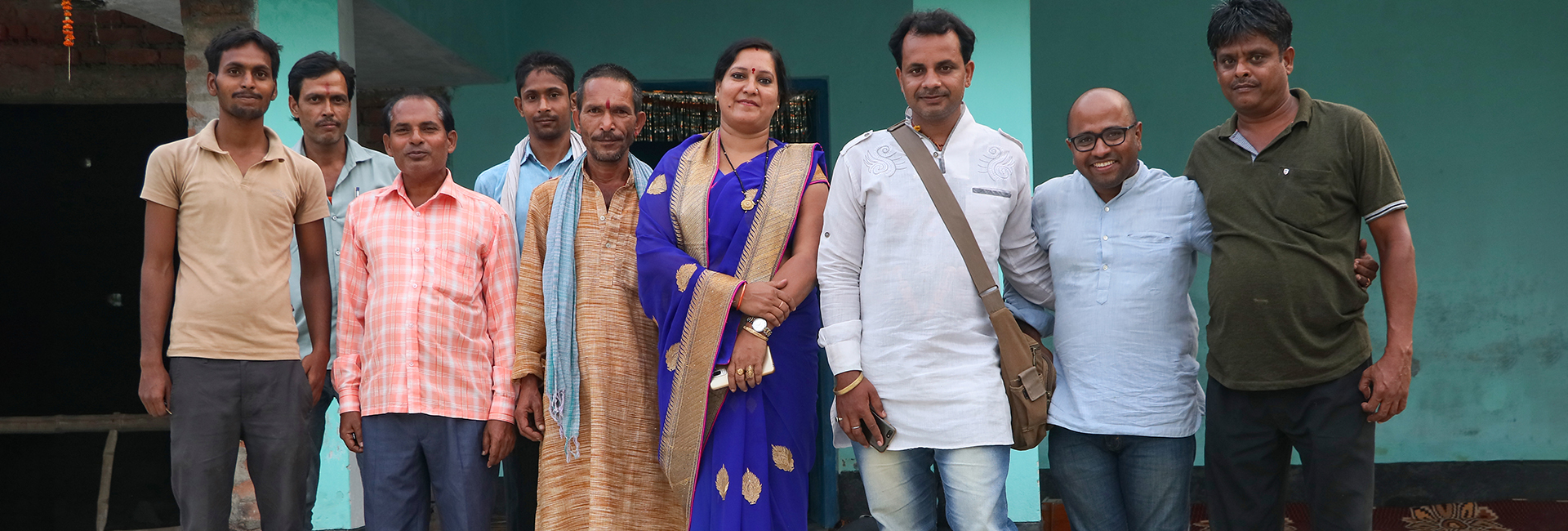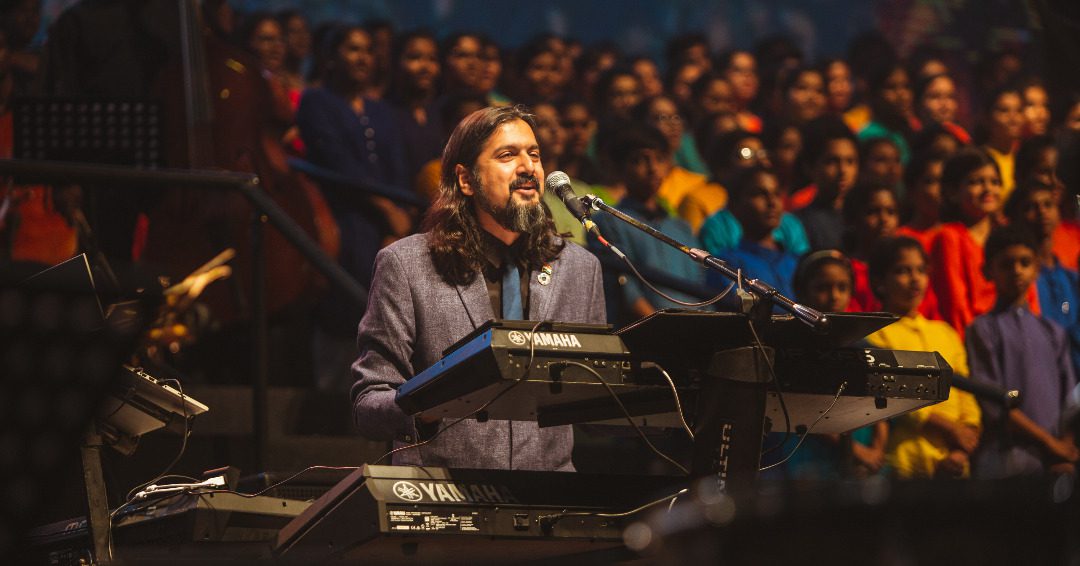(July 24, 2024) Itna bata ke jaiyo, kaise dinwa beeti ho ram
(While you are going, tell me how should I spend my time?)
It’s a woman’s cry, pleading with her husband or lover, who is moving to foreign shores as an indentured laborer, to return home soon. More than 100 years later, these words of pain and longing have been kept alive through Bidesia — a genre in Bhojpuri folk music, loosely translated as “migrant.” Passed down through generations, this oral tradition is preserved in the heartland of Uttar Pradesh and Bihar by local artists. An art form that Mumbai-based documentary filmmaker Simit Bhagat is working to safeguard and conserve. “Bidesia is a form of Bhojpuri folk music that emerged in the mid 1800s when many men from UP and Bihar migrated to British colonies as indentured labourers, leaving their women in perpetual waiting and anguish. Music served as a balm for their pain and longing,” Simit tells Global Indian. To prevent this music from fading into obscurity, he made a 90-minute documentary, In Search of Bidesia, in 2019. The film premiered at the Dhaka Film Festival and won the Best Music Documentary at the Royal Anthropological Institute Film Festival in the UK in 2021.

Simit Bhagat with a Bhojpuri folk artist
A chance encounter with local artists in a village in Uttar Pradesh introduced Simit to Bhojpuri folk music, a genre largely unknown to the broader population. This instant connection nudged him to explore more and led him to the home of renowned artist Mahendra Mishra in Chhapra, Bihar. The three-day stay to record music inspired Simit to share the stories and melodies of these local artists. “He told me he doesn’t care about money, but he wants his music to reach people. Those words stayed with me. If I can help bring their music to a wider audience or give these musicians a platform, that would mean everything,” says Simit, who founded The Bidesia Project.
“The songs have been in the veil of oblivion for too long. It’s time the world knows about Bhojpuri folk music,” he adds.
Journalist-turned-social development practitioner
With his roots in Konkan, Simit considers himself a Bombay boy after his parents settled in the city for a better life. A chance encounter with a journalist in his neighbourhood during his childhood left him in awe of the profession. “Seeing his confidence and authority, I was spellbound. That’s what first attracted me to journalism,” says Simit, the youngest of three siblings. A diploma in journalism opened up new horizons, shaping his worldview and landing him a job at the Times of India on the environment beat. After five years, his passion for social impact and development prompted him to pursue a master’s in Society and Development at the University of Sussex. His year in Brighton broadened his perspective on development issues and taught him to enjoy life more.

Armed with newfound knowledge, Simit returned to India in 2011, eager to make a tangible impact. “I wanted to move beyond research and apply what I had learned on ground.” He joined a UNDP project with the Mangrove Foundation in Sindhudurg, Maharashtra, to sensitise community on marine biodiversity. In the small town with limited social life, he’d spent weekends exploring nearby areas on a colleague’s bike with a camera in hand. This led to his first documentary, My Disappearing Farms, which addressed Sindhudurg farmers’ declining interest in farming, causing the next generation to seek small jobs elsewhere. “That’s how my journey into visual storytelling began,” Simit reflects.
Brush with Bhojpuri folk music
Later, he joined Tata Trusts, travelling across the country to identify organisations and fund their projects. Simultaneously, he satiated his creative side. “I’d always carry a camera and shoot short videos.” One such program visit took him to Delupur village in Jaunpur district in Uttar Pradesh, where he discovered Bhojpuri folk music for the first time. “I was fascinated. Everyone in that village could play an instrument and sing,” he recalls. He immediately recorded the performance on his phone. Even months after returning, the music stayed with him. “I often listened to the recording, and something in me urged me to dig deeper into this,” says Simit, who has been passionate about music since childhood.
In 2017, Simit took a short break to explore Bhojpuri folk music. “I crisscrossed across UP and Bihar on my bike for 15 days, starting from Allahabad and travelling through Ghazipur, Benaras, Buxar, Ballia, and Lucknow. With no plan, I’d randomly land up in villages inquiring about local artists. The universe conspired and I kept meeting one artist after another, recording their music. By the end, I had recorded 1 TB of footage,” smiles Simit.
Bhojpuri folk music is an oral tradition passed down through generations. “It’s an expression for people who have songs for different seasons and reasons,” says Simit, adding that Chaiti songs are sung during Ram Navami, while Kajri songs celebrate happiness and prosperity during the month of Sawan. Ropani songs resonate through farmlands during the sowing season. He recorded 92-year-old Saraswati Devi singing Jatsaar, songs of the grind mill. “Since grinding is arduous and requires physical energy, the women sing to encourage themselves, with themes of pain, migration, nature, and seasons,” Simit explains. Passed down to her from her mother, the song held a special place in her heart. “A few months later, she passed away and I realised if I hadn’t recorded it, it would have disappeared into oblivion. That’s when I understood the importance of preserving the intangible culture.”
Bidesia music – songs of migration
One form of Bhojpuri folk music is Bidesia – migration songs. While many people from Bihar and UP currently take blue-collar jobs in metro cities, Simit says this migration trend isn’t new. “During colonial times, people from UP and Bihar migrated to British colonies like Fiji, Mauritius, and Suriname as indentured laborers on five-year contracts,” he reveals. After slavery was abolished, plantation owners needed workers to maintain sugar production, the colonial empire’s main source of income. “They sought docile, abiding labourers and even tried Chinese labours but failed. Dubbed the Great Experiment, British officials turned to Indians who were reported as hardworking,” explains Simit, who found this information documented in the UK Archives during a visit to London.
In the hope of a better life, many people from these states agreed to leave for foreign lands. Calcutta being the nearest port, saw large numbers shipped out. “Since this region was impoverished and people couldn’t read or write, many false promises were made,” Simit reveals, adding, “Those taken to the Dutch colony of Suriname were told they were going on Sriram’s yatra, and Mauritius was referred to as Maarrich Taapu, stating it was a two-hour journey.” But it took them months to reach their destinations. Many died on the journey due to harsh conditions, as most had never even left their villages.
The migration to distant lands led to many broken families. With no letters, women waited for their lovers and husbands to return, giving birth to Bidesia music. “These were songs of separation and longing that women felt. Interestingly, certain songs are from a man’s perspective, explaining to women the reason for migrating to foreign lands.”
The migration to British colonies included not only men but also some women, particularly widows. “With no social standing, these women often took the recourse of migrating to foreign lands. Moreover, they were paid higher wages than men due to the skewed sex ratio in places they were taken to, to maintain balance in society,” explains Simit. Upon arrival, indentured laborers would wake up at 3 am and work in the fields all day. Even after the expiration of five-year contracts, these labours had no way to return home. “With limited or no money and their documents controlled by plantation owners, escape was nearly impossible. It was more like a trap, and many committed suicide upon realising they had no means to return,” Simit reveals.
The women continued to wait for their men to return, singing songs that were passed down to generations. Over time, oral traditions are dying with the emergence of popular music, which makes it crucial to preserve and conserve them. While migration now primarily occurs within the country, Simit notes that even the lyrics and music of Bhojpuri folk have evolved. However, he quickly points out, “Bhojpuri folk music is pure and nothing the popular Bhojpuri music. The local artists don’t consider it an art form.”
The Bidesia Project – Promoting local artists
After two weeks on the road, Simit had amassed enough footage to realise that a 90-minute film couldn’t do justice to the many local artists he encountered. “I knew it required a larger initiative to systematically document this music before it vanished. I wanted to create an archive where people could access and understand this music. That’s how the Bidesia Project was born.” As part of the project, Simit continues to record music when he can and uploads it to YouTube for wider reach. He often finds an audience among people from the Caribbean looking to reconnect with their roots. “These songs serve as a common thread connecting people from UP and Bihar, both in India and abroad,” says Simit.

Simit Bhagat
Through the Bidesia Project, Simit aims to conserve and preserve Bhojpuri folk music, which is at risk of disappearing. “There’s so much work to be done, and I don’t think we’ve even covered one percent of it due to my struggle to balance work with passion,” says Simit, who runs an award-winning creative agency. He plans to scale up the project by adding more resources, ensuring it is not reliant on just one person.
Simit, who loves swimming and traveling, is also learning electronic music production. “I have a deep connection with music, which drew me to Bhojpuri folk music even when I didn’t understand the language. Now, I want to bring this music to a wider audience and lift it from the shadows of obscurity.”
Also Read: Dr. Sarita Boodhoo: A champion for Bhojpuri heritage in Mauritius
Also Read: Hanumankind: The Indian rapper taking global music scene by storm




